|

Mountain Spirit Guides: Backcountry Skiing/Ski Mountaineering
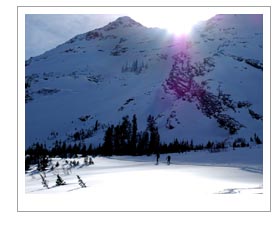 Mountain Spirit Institute Backcountry Ski and Mountaineering programs offer something a bit different than other services. We believe the "freedom of the hills" provided by the ski, comes with the responsibilty to get involved in what is around us, not only by taking in and being aware of the environment around you, the sights and sounds, but learning about the land use issues and mountain cultures and environments we visit. Mountain Spirit Institute Backcountry Ski and Mountaineering programs offer something a bit different than other services. We believe the "freedom of the hills" provided by the ski, comes with the responsibilty to get involved in what is around us, not only by taking in and being aware of the environment around you, the sights and sounds, but learning about the land use issues and mountain cultures and environments we visit.
Credentials: R. Richards has been a backcountry ski guide since the early-'80's and a high altitude mountain guide since the mid-'90's. He has guided the Haute Route a number of times, routes in Austria, the Sierra Neveda, and the Wasatch. He has been an individual member of the AMGA since 1984. MSI guides legally, using UIAGM guides as co-leaders (or lead guides), where required, land use permits where requred, and operate with full liability insurance from Worldwide Outfitters and Guides Association.
We operate in small groups with experienced local guides who are also skilled facilitators who have a passion for sharing their local knowledge, history and love of the mountains. Getting involved in our surroundings means doing a service project associated with the region or land agency who hosts us. This usually takes place near the end of the program. Also learning a bit of the local language and something about the people of the regions through which we pass are integral parts of our programs.
Image: Utah Backcountry
Classic Haute Route 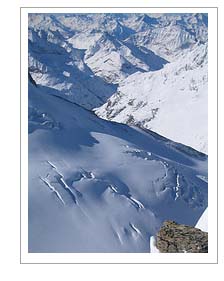 The most famous ski tour in the world, traversing the heart of the alps from Chamonix, France to Zermatt and Saas Fee Switzerland is an experience that lives in one's memory forever. It crosses fifteen major glaciers and maintains an average altitude of 8500 feet. Swiss Alpine Club cabins in spectacular settings, located along the rou * te will be our nightly havens. Will will cross remote passes and navigate through many different types of terrain. We will take our time along the way, but the climbing and physical demands are strenuous. The route takes us over the higher version of the two variations, just south of the Grand Combin near the Italian boarder. The most famous ski tour in the world, traversing the heart of the alps from Chamonix, France to Zermatt and Saas Fee Switzerland is an experience that lives in one's memory forever. It crosses fifteen major glaciers and maintains an average altitude of 8500 feet. Swiss Alpine Club cabins in spectacular settings, located along the rou * te will be our nightly havens. Will will cross remote passes and navigate through many different types of terrain. We will take our time along the way, but the climbing and physical demands are strenuous. The route takes us over the higher version of the two variations, just south of the Grand Combin near the Italian boarder.
Image: Haute Route
Routes
- Aiguille des Montets and the Argentiere Cabin
- Col du Chardonnet
- Trient Glacier and the Cabine du Trient
- Col des Ecandies then descend to Champex
- travel to Bourg St. Pierre to trailhead
- Velan or Valsorey Cabin
- ascend the south shoulder of the Grand Combin
- ski to the Chanrion Cabin
- ascend the long Glacier d1otemma to the Vignettes Cabin
- traverse to the Col de L'Eveque
- Col de M. Brule
- Col de Valpalline and the Shonbiel Cabin
- descent to Zermatt
- ascend to the Gorner Glacier to the Monta Rosa Cabin
- traverse to the Adler Pass and the Britannia Cabin
- descend to Saas Fee
Austrian Arlberg
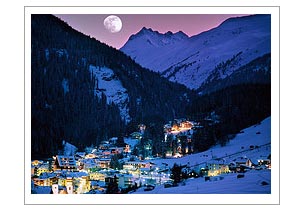 MSI's version of skiing the Arlberg is a combination
of lift served skiing (taking a tram to reach the higher ground) and backcountry ski touring and inter-village ski touring. One night might be in the historical Hospiz Hotel in the small alpine village of St. Christoph, the next night in a tent at the base of the Kaltenberg Glacier or the Schafeberg Mountain. In order to take advantage of all the terrain the Arlberg offers, one must ski with a guide/instructor who knows the area. The area's strengths lie in its backcountry where few go, behind the corner where the bowls and snowfields wait. The nature of the skiing changes greatly with the seasons, from powder in January and February to spring skiing on miles and miles of corn snow,in March and April. We ski powder/corn snow runs that consist of 4 to 7 miles and more. MSI's version of skiing the Arlberg is a combination
of lift served skiing (taking a tram to reach the higher ground) and backcountry ski touring and inter-village ski touring. One night might be in the historical Hospiz Hotel in the small alpine village of St. Christoph, the next night in a tent at the base of the Kaltenberg Glacier or the Schafeberg Mountain. In order to take advantage of all the terrain the Arlberg offers, one must ski with a guide/instructor who knows the area. The area's strengths lie in its backcountry where few go, behind the corner where the bowls and snowfields wait. The nature of the skiing changes greatly with the seasons, from powder in January and February to spring skiing on miles and miles of corn snow,in March and April. We ski powder/corn snow runs that consist of 4 to 7 miles and more.
Image: Lech am Arlberg, with Zurs in the background
Routes
-
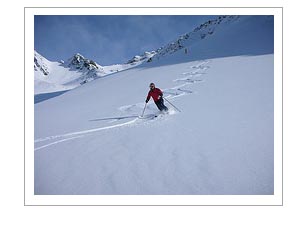 The alpine villages of Lech The alpine villages of Lech
- Zurs
- St. Christoph
- St. Anton
- Stuben
- Warth and Steeg
- Schafberg Mountain
- Kaltenberg mountain
- Valluga, the highest peak in the Arlberg
- Lake Spuller area
Image: Austria Backcountry
Utah
 R Richards has spent decades in this area of the world. Having graduated from the Univeristy of Utah ( read: U. of Snowbird) and lived above Alta, this is where Richards first learned the mountaineering and backcountry skiing in the late '70's, and became familiar, and fell in love with the Wasatch Range before moving on to the Alps, then the Washington Cascades and the Andes. He has returned to live and ski in the Wasatch since 1976. R Richards has spent decades in this area of the world. Having graduated from the Univeristy of Utah ( read: U. of Snowbird) and lived above Alta, this is where Richards first learned the mountaineering and backcountry skiing in the late '70's, and became familiar, and fell in love with the Wasatch Range before moving on to the Alps, then the Washington Cascades and the Andes. He has returned to live and ski in the Wasatch since 1976.
This area hosts the best snow in the world. The lightest, the driest powder lies in Big and Little Cottonwood Canyons just east of Salt Lake City. This is Alta and Snowbird taken one step farther, behind the ski areas of Solitude, Brighton and Park City. Occasionally we use lifts to reach the high altitudes and backcountry valleys. The rest of the time we use climbing skins to gain the high country. Lodging can be in the valleys' accomnodations or nightly camping in the high country, or a combination of the two, depending on weather and season.
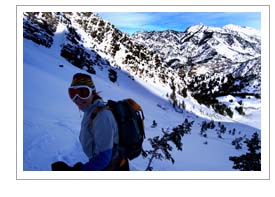
Note: We are in the process of contacting the local land use agency and the local permit holders for co-leading this program.
Routes
- Red Pine Canyon
- White Pine Canyon
- Catherine Pass
- Twin Lakes Pass
- Merril Flat and Mary Ellen Gulch
- Mill B South Fork and Lake Blanche, Lake Florence and Lake Lillian
- Mineral Fork
- Mill D South Fork
- Days Fork
- Silver Fork
- Honeycomb Fork
- American Fork
Details
Travel Connections and Details:
Connections to Austria are usually through Zurich International or Munich. To Chile or Argentina through Santiago, Chile. Connetions for skiing the Haute Route are through Geneve.
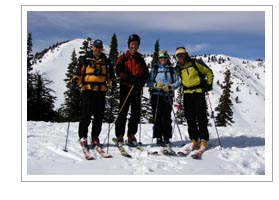
Rating:
Clients should be in excellent physical condition and be capable of strong parallel skiing. Some background of skiing in alpine areas (Snowbird, Alta, Vail, Jackson Hole) is helpful in dealing with altitude, powder skiing conditions, avalanche awareness and conditioning.
Optimal Seasons:
Haute Route:
Last week in April until the end of May
Utah:
Late winter, early spring
Austria:
January through mid April or later depending on the snow that year.
Peru: April-June
Chile/Argentina: Late summer-Fall
Special Equipment Needed:
CLIENT SUPPLIED: AT or telemark skiing equipment, climbing skins and both ski and boot crampons, avi-transceivers*, all personal cold weather clothing and eye protection, sleeping bag, personal camping equipment such as flashlight, water bottle if camping is desired. Please refer to or request list of suggested basics.
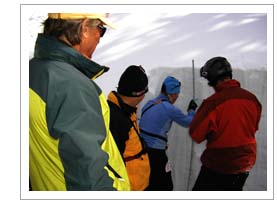 GUIDE SUPPLIED: Safety and avalanche rescue equipment including, shovels, avalanche cord, tents, cooking equipment maps, avi-transceivers*. *Depending on the program, either the program lead, or the participant will provide the avalanche transceiver. GUIDE SUPPLIED: Safety and avalanche rescue equipment including, shovels, avalanche cord, tents, cooking equipment maps, avi-transceivers*. *Depending on the program, either the program lead, or the participant will provide the avalanche transceiver.
Images: Powder Moutain, Utah, Backcountry Training Program
R. Richards
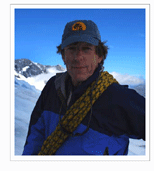 Mountain Spirit Institute’s Founder & Executive Director, R. Richards started ski-guiding in the Austrian Alberg backcountry in the early 1980's when he lived in Lech and Zurs, Austria and South Tirol, Italy. and later, the Classic Haute Route from Chamonix to Saas Fee. He is intimately familiar with these regions. It's where he got his "mountain sense". Mountain Spirit Institute’s Founder & Executive Director, R. Richards started ski-guiding in the Austrian Alberg backcountry in the early 1980's when he lived in Lech and Zurs, Austria and South Tirol, Italy. and later, the Classic Haute Route from Chamonix to Saas Fee. He is intimately familiar with these regions. It's where he got his "mountain sense".
He is certified PSIA Level-III Alpine ski instructor(at the age 18 in 1976), and certified PSIA Level II Backcountry Ski Guide since the early '90's, and PSIA Level II Telemark Instructor. He has been an individual member of American Mountain Guides Association since 1984.
Randy has also served as a ski-guide for Alan Bard in the High Sierra Nevadas, and as a Senior Guide in mountaineering for Alpine Ascents International in South America on high altitude expeditions such as Aconcogua in Argentina, and Peru's Huascaran (where he was co-leader of the these expeditions), the volcanoes of Ecuador, as well as on the North Cascades' volcanoes. His years of teaching mountaineering and skiing has earned him a reputation as a safe and compassionate instructor from many of his students and clients. He has had extensive wilderness emergency medicine training and is a current E.M.T. which he has held continously since 1985. He has participated in the American Mountain Guides Association first AMGA Ski Guides course and American Avalanche Institute Level II program. He speaks German, French, Spanish, and some Quechua and a bit of English.
Local permit holding/licensed guides and partner agencies will be working with Randy in each of the aforementioned regions.
MSI is a fully insured non-profit educational organization
Register
If you're interested possibly skiing with R. Richards in these areas, please contact us.
Return to Top of Page
PHOTO CREDIT:
|





